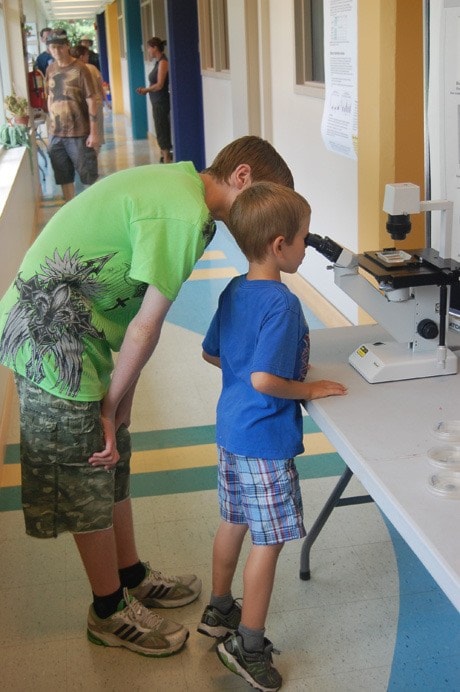by Adrian MacNair
A bounty of bursting blueberries and red raspberries were plucked in earnest from the displays by visitors at the Pacific Agri-Food Research Centre open house on Saturday.
The displays of the Fraser Valley's luscious fruit is the product of 126 years of scientific research into perfecting farming techniques in the mild and moist climate so famous for producing B.C.'s fruits and veggies.
Hundreds of people pored over the laboratories, greenhouses, and fields that make up the 310 hectares of one of Canada's 19 research centres dedicated to agriculture and food production.
In one display, visitors were encouraged to look through powerful microscopes at the parasites that afflict fruit crops, with a biologist on hand to explain how farmers deal with the pests.
Tom Forge, a root system microbiologist, said these parasites attach themselves to the roots of raspberries, reducing the yield in each subsequent year until the entire crop has to be removed and replanted.
Although in the past farmers have relied on chemical warfare to deal with these issues, scientists here are looking at alter-natives.
"One of the things we're research-ing other than fumigants is using different manures, composts, and organic soils," he said.
That research is part of the Integrated Pest Management program, which is bundled with soil, water, and air quality management into Environmental Health, a national science program within Agri-Food Canada.
A second national science program Agassiz tackles is Sustainable Production Systems, which looks at developing systems of crops (such as the varieties of blueberries and raspberries on display) and livestock production that are environmentally sustainable.
The entire scientific branch here can be classified as peri-urban agriculture — essentially studying the impact of outlying urban areas on farming — according to Dr. Sankaran KrishnaRaj, director of operations since April 2011.
KrishnaRaj said the centre focuses on research important to growers associations — whether it be chemical, physical or biological — to compete in a global marketplace.
This year KrishnaRaj decided to coincide its open house with another food event, the Slow Food Agassiz Cycle Tour, in which cyclists visit a 25-kilometre circuit of local farms.
"It attracts not only the common people interested in the slow food cycle tour but also how the production of food works," he said, adding some people are surprised at the size and scope of the centre.
"Sometimes when they see us they are surprised we've been here 125 years and they didn't even know it."
Agassiz's research centre was one of five original Dominion Experimental Farms established in Canada in 1886, which began by experimenting with varieties of cereal grains, corn, root crops and potatoes.
Some of the most popular wheat growing techniques and 40 per cent of the raspberry varieties found on supermarket shelves were developed in Agassiz, said KrishnaRaj.
There are 22 research professionals and 21 technicians working on site, many on the cutting edge of agri-food research. Dr. Dave Gillespie won the 2011 Gold Harvest Award from Agriculture and Agri-Food Canada for his breakthroughs in biological control agents.
As well as laboratories, greenhouses, and field crops, the centre hosts a poultry research facility, feedmill, insect rearing rooms, arboretum, a weather station that's been in operation since 1889, and a heritage barn from 1893.
For more information on Agassiz's Agri-Food research centre, visit www.agr.gc.ca.
